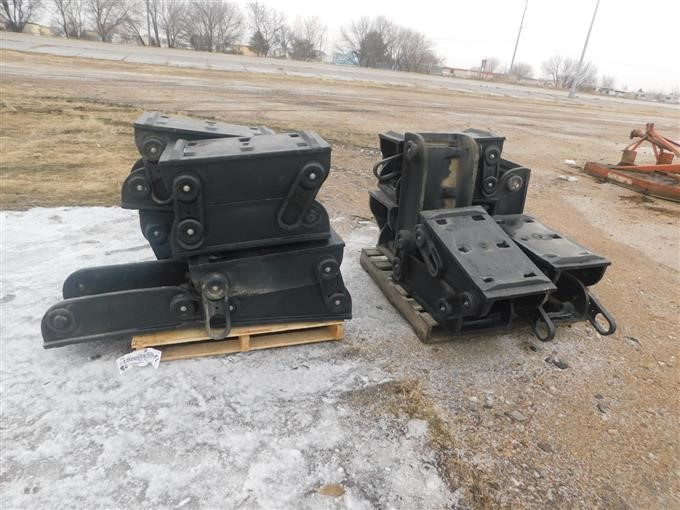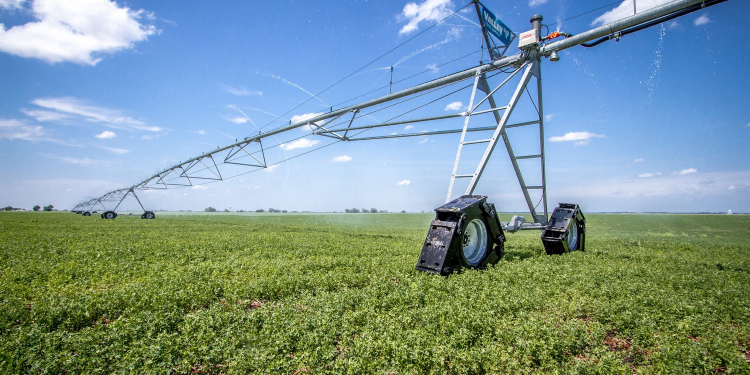Ruts have been an issue with center pivot irrigation systems since their inception over 70 years ago. Ruts are formed as soil is displaced as the tires on the support towers roll through the field. This displacement of soil is caused by two primary factors- static buoyancy limits and dynamic displacement.

The static buoyancy limit is simply a function of surface area, the weight supported, and the soil loading capacity. Think about loading a boat; the more weight one puts in the boat the deeper the draft depth. Inversely the bigger the boat, the more weight one can load into it without significantly increasing draft depth. Typically this factor has been dealt with by installing larger tires or a wheel add-on that increases the wheels contact surface area.
Dynamic displacement occurs as a result of the motion of the tire’s surface. When the tread moves through the soil, it displaces soil through direct force, i.e. it digs. This can be caused by a number of environment factors: hills, soil condition, worn tires, overly aggressive or ineffective tire tread patterns, etc but it is also happening constantly by the very geometry of the pivot’s motion. Two tires supporting a tower rolling in a circle, those two tires constantly micro-adjust to realign themselves to the circular direction of travel. The impact of this constant micro-displacement is directly related to the time the pivot is run in any particular season. Hence the longer one runs a pivot, the deeper the ruts.
As mentioned before, the traditional solution to rutting issues has been to simply apply bigger and bigger tires until a tolerable depth of rut is achieved. While this method does marginally address the static buoyancy limit, it does nothing at all to address the dynamic displacement factor and in fact, often makes it worse with the aggressive treads often associated with the larger tires.

On the other hand, RAAFT tracks effectively address and eliminate both factors. The static buoyancy limit is solved with a footprint of 520 square inches, over 5 times the contact area of a typical 11.2 x 24 series tire (Models 525 and 526). The RAAFT Model 700, which fits 14.9×24 series tires, has a footprint of over 700 square inches. This much larger stationary contact area is enough to handle virtually any soil condition, even standing water.
Perhaps more significantly though, RAAFT Tracks also address the problem of dynamic displacement which sets it even farther ahead of any other solution on the market today. This is due to the unique action of laying down a track for the tire to roll over and through and thus dramatically reducing the dynamic displacement factor of rutting. Virtually no soil is displaced through thrust motion because the rolling moment happens between the tire and the track, not the tire and the soil.
The pad lays down flat and stays immobile while under load as the tire rolls through it. The ability of the RAAFT track to self-align and stay immobile is due to the unique multi-planar adaptive joint used exclusively by RAAFT tracks. This joint allows the pad to adjust for slope in any direction but more importantly dramatically reduces the motion of the pad as it moves through the field. Less motion equals less dynamic displacement.
Benefits
To start, fields are not even and the landscape seems to change almost daily. There are many different factors that come into play, but tackling an uneven field is definitely a challenge. For this reason, Raaft Tracks were designed to be versatile and handle the changing landscape of any field. In turn, Raaft Tracks will keep your pivots moving so you can rest easy. In addition, bridges, washouts, and hills are no match for Raaft.
Additionally, Raaft Tracks will effectively prevent soil erosion. Soil erosion is a major issue in the agriculture community. It is sometimes caused by deep ruts. But, because the design of Raaft eliminates rutting, soil erosion is eliminated as well. Not only that, but Raaft Tracks increase the absorption of soil water due to the imprints that it creates. In addition, you can look forward to no more pivot track washouts.

Also, did we mention that Raaft Tracks are recyclable? That’s because they are made using food grade, UV protected plastic. By making our product 100% recyclable, our aim is to help preserve our environment for future generations.
Most importantly, is the amount of time, energy, and water you’ll save by saying no to further ruts. Because Raaft tracks have such a unique design, they can help reduce stress on drive trains. In addition, your tires will be protected from punctures or flats as the pivot moves around your field. Raaft tracks stay on top of soil, rather than getting stuck or slipping.








